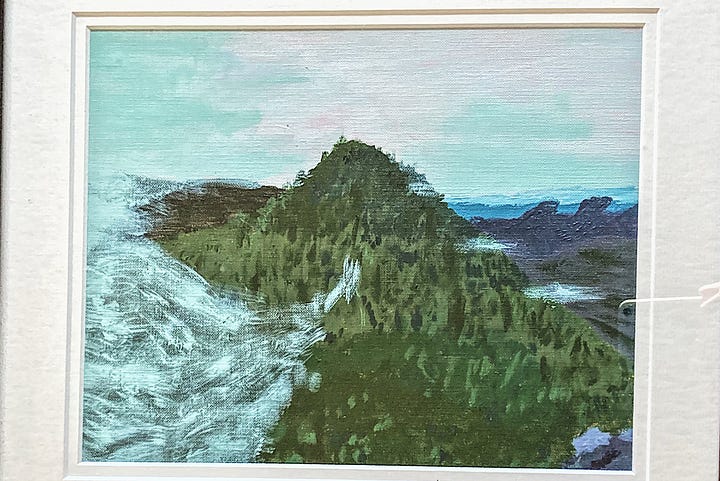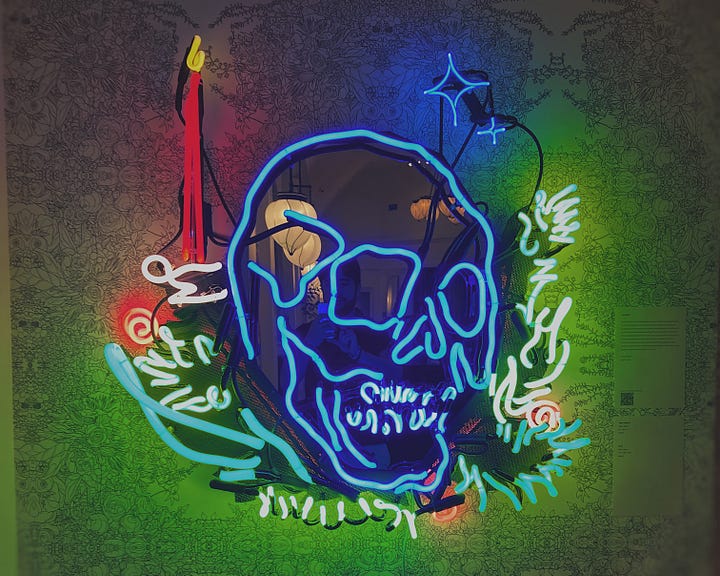Hello! Thanks for reading Tangent. This week’s essay is about how I fell in love with visual art. Let me know what resonates in the comments. Enjoy!
Just Like Matisse
I used to not give a shit about art.
That changed one day, thanks to a neatly packaged epiphany that life seldom gives us.
December 23rd, 2013. Vienna, Austria. *cue The Blue Danube*
My original plan was to visit as many Google Maps-recommended coffee shops as possible and journal. A tour de caféine. In between stops at historic places like Cafe Havelka and Cafe Sperl, I found my way to the Albertina museum.
#Museumboi
Its cream color facade drew me in. It looked like one of those places you don’t know if it’s a cake or not. Back then, I thought of museums as ancient buildings that held things I had little interest in. Yet, I decided to go in. It was time to become more cultured.
The main exhibit was titled “Matisse and the Fauves.” The Fauves, which translates to wild animals, was the nickname given to a group of artists (Henri Matisse, Andre Derain, Maurice de Vlaminck, among others) after their paintings caused uproar at the Paris Autumn Salon in 1905. Their work had intense colors, aggressive, sloppy strokes, and was loose on proportions.
Art critics thought these guys were out of their mind. Amateurs. The Fauves couldn’t care less. They cared about expression. Art didn’t have to be true to the natural world anymore. It became a vessel for expression. A bridge towards something deep inside us.
I was seduced by the colors, enthralled by their interpretations of bodies, buildings, and ships. The Fauves were trailblazers. Along with art movements like Expressionism and Cubism, they gave birth to modern art.
I was hooked.




I left the Albertina transfixed by the works of The Fauves. I hold a special fondness for Matisse. More than his craft, he made me truly feel art for the first time. At the time, this didn’t make sense to me. I’d been molded by square business school classrooms and I was working at Boeing. My beliefs were: Engineering is progress. Business is progress. Art is decorative. Superfluous.
This feeling hinted that my view of art was incomplete. These works told stories. That had value. I didn’t know why, but I knew my opinion of art had been too reductive until that point.
My travels in Europe that winter were now colored under the rose-colored glasses of my new found love for art. While in Amsterdam, I learned about Rembrandt and Van Gogh. In Madrid, I went to El Prado, and realized how much I hate being in a room filled with “classic” paintings of babies, saints, and virgins.
I made the point of visiting museums in subsequent travels. Learning bits here and there about Picasso, Klimt, O’Keefe, Kandinsky, etc.
All of sudden, I had become #Museumboi.
Brush Meets Canvas
Every time I learned more about an artist, I felt a yearning to do what they did. I wanted to paint. My mind, a very active artist, would conjure scenes inspired by them. I obsessed over these mental images, daydreaming about them over and over like a pretty girl I saw while walking on the street and never wanted to forget.
This went on for about 6 years. Mental image, daydream, no painting. I didn’t dare to pick up a paint brush. I resolved that writing was the only creative medium I was even remotely talented in. Why press my luck?
Then, COVID happened.
Everyone picked up a COVID hobby. Some people made bread, others got into gardening. I picked up a paintbrush.
I took a virtual Desert Landscapes in Acrylics class from Danika Ostrowski. A few middle aged women and I would huddle through a Zoom screen and watch Danika teach us the basics of color theory, brushstrokes, and proportions. My eyes would pinball back and forth between the screen and the canvas, ensuring that I was laying the edge of the brush at the same angle as my instructor. I wanted the lines to be perfect. My teacher would have us hold the canvas against the screen and assess our progress. She was soft like Filbert brush. She encouraged us to not be too concerned about precision, to enjoy the mistakes. I wanted the lines to be perfect.
Despite my perfectionist tendencies flaring up like a bad rash, I managed to make decent landscapes. I was able to take a canvas from nothing to something. It was addictive. I painted grass, lots of grass. I painted trees; loose leaves, lush, in-between seasons, and Christmas trees. If you’ve ever played golf, you get the same rush as when you tweak your swing ever so slightly, and the ball suddenly starts obeying you just a little more.




I made time for painting after work, and on the weekends. It seemed preferable over having to walk everywhere with a mouth diaper. I thought of my younger self, so afraid to pick up a brush, and asking him “what were you so afraid of?”
I remembered reading that Van Gogh didn’t start painting until he was 27 and he was self-taught. I’m 30, but I had YouTube, so I could catch up.1
I painted for about a year. Then, I started plateauing. I wasn’t learning anything new, I kept trying to paint the same grass over and over. Snowy mountains still looked mushy. I tried abstract paintings and I felt childish. I tried portraits and felt like the Spanish artist who tried to restored a painting of Jesus and delivered a world-famous fuck up.


The stagnation weighed heavily on me. I decided to double down on writing. I saw my creative energy as finite and part of a zero-sum game between my work and personal life.
I put the paintbrush away.
The In Between
Sabbatical life creates an existential void that invites random questions in the shower. Why does art matter? Why does art matter to me? I reckon my inclinations for art would be different if I had been a math savant, or if my physics teacher had a little more patience with me.2
But here’s where I am today: In love with art, but afraid to love it.
I live by the principle that creative expression is fundamental, that inspiration begets action, and that artists must produce and consume so taste and craft improve. Do this intentionally for long enough and life will be richer.
I’ve done a good job consuming art. I’ve read books on different art movements (my favorite being What are you looking at? by Will Gompertz). I make a point of visit museums everywhere I go. I recently volunteered for a Seattle-based art organization called XO Seattle that took over a historic building and turned it into a gallery with fantastic local art and installations.




But I’m by no means a visual artist. It would have been great for this essay for me to tell you, “I’m painting again!” For my art journey to take a heroic turn, hoisting a masterpiece while being carried on someone’s shoulders through an adoring crowd, as Van Gogh’s face in the clouds gives me an approving smile that says “you did it, my boy.”
The paint brush still sits dry.
I’m in an in-between–a liminal space between inspiration and action. I’ve realized the only reason I sustain this tension, instead of quitting altogether is because it serves a broader purpose: I want to understand why art matters. To answer this question, you have to engage long enough in the practice of creating art.
Because if our civilization were a person, science is the body, and art is the soul. I know this instinctively. However, if you asked me to prove that in writing, I’m afraid I couldn’t at this point. That is the also part of the pursuit: To explain why art and science are inextricable partners. Why STEM vs. Art conversations are foolish–like saying we don’t need nights or the moon, the sun is all we need.
The upside of this pursuit is that the canvas is still fairly empty, I can craft it in ways I can’t even predict. That’s the beauty of the creative process. Perhaps my past self needs to ask my current self “what are you so afraid of?”
Once I pick up the brush again, my lines won’t be straight. They will probably be wild.
Just like Matisse.
Afterword: I do consider photography a visual art of incredible craft. For brevity, I’ve omitted talking about photography in this essay. If you’d like to see some of my photography, you can do so by visiting this link.
Catch up in terms of his prolific output, not his depressing end. I love my ears far too much.
In his defense, you can only ask someone to explain f=ma so many times before both of you realize that maybe you are not Isaac Newton.







I, as well, didn't "give a shit" about art before. Like the one hanging on museums. But I always had some sensibility to it (maybe due to upbringing).
I have never painted anything like you but I have made figurines of clay plasticine, origami, and pencil drawings.
What's funny is that I studied Computer Science in college and all that artistic flair was tucked away.
And so, I'm like you in a space with some inspiration but with no action because doing work that gets paid takes precedence.
You have a great ability at nuanced, smart humor. Maybe that's the next art stop? A stand up tour? Haha great essay Camilo! Enjoyed reading about your journey with art, it resonated a lot, especially on the growing appreciation for museums when younger and how that all came into place knowing about art history.
Also admire you for turning a passive appreciation onto an active one by picking up a brush.
Speaking of Matisse, I recently discovered a new favorite artist contemporary of his called Gustave Caillebotte. His painting The Floor Scrapers made a big impact on me, for a reason I can't quite pin down.
Anyway, excited to see how your relationship with art keeps evolving!